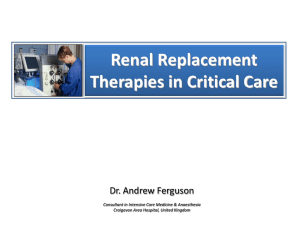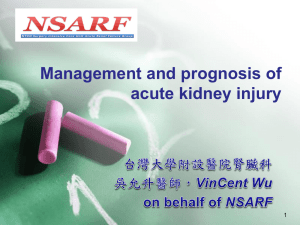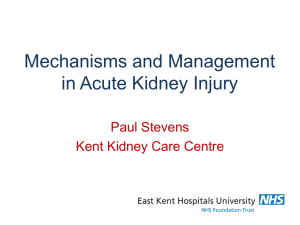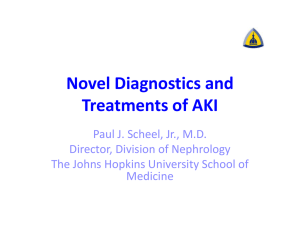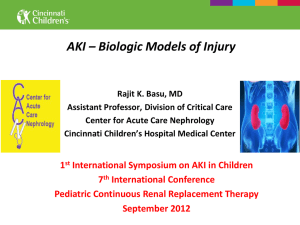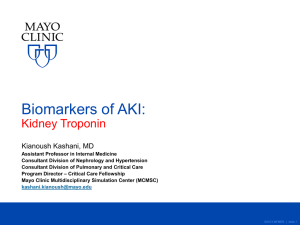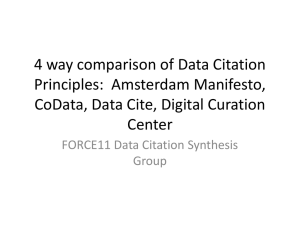Askenazi-Neonatal - Pediatric Continuous Renal Replacement
advertisement
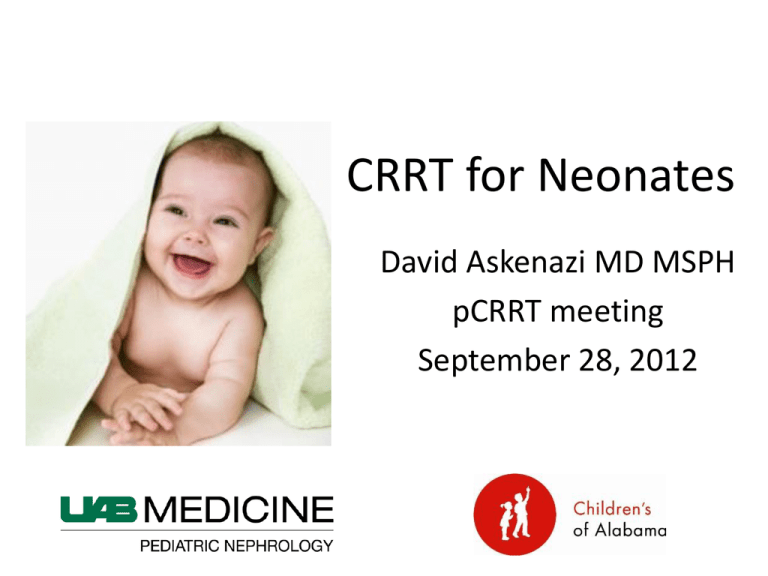
CRRT for Neonates David Askenazi MD MSPH pCRRT meeting September 28, 2012 Transparency…. • I am on the speaker’s bureau for Gambro • Will not be discussing specific differences of CRRT machines • I will be talking about non-FDA indications for Devices – No CRRT devices are approved for < 20 kg. Educational Objectives • • • • Acute kidney injury and CRRT epidemiology Indications for RRT in children Type of RRT – PD vs. HD vs. CRRT Prescription of CRRT for pediatric patients – – – – – – Vascular access Priming the machine Anticoagulation Blood flow rates Clearance Net ultrafiltration goals Children are not small adults • Different Sizes, and Shapes 0 days to 21+ years 1.3 kg to 200 kg Not present ◦ ◦ ◦ ◦ ◦ Diabetes Older age Atherosclerotic disease Hypertension Volume of patients Present ◦ Size/Access variation ◦ Less frequent than adults/less experience ◦ Machinery is adapted (not made) for pediatrics Small Children are not Big Children • Blood Primes • Access • Machines are Really not designed for small children – Need high blood flow /kg – Need high clearances for citrate clearance • Thermic Control is critical • Not FDA approved for small children “Just pull off the sticker” “Explain it to the family” Indications for RRT in the ICU A -- Alkalosis or Acidosis ( metabolic) E -- Electrolyte disturbances -- Hyperkalemia -- Hypernatremia -- Hyperphosphatemia -- hypocalcemia -- hypercalcemia -- hyperuricemia I -- Intoxication with a drug that can be dialyzed I – Inborn Error of Metabolism O -- Overload of Fluids ( H20 retention) -- Pulmonary edema or hypertension U -- Uremia - Not azotemia which can be secondary to steroids, bleeding -- CNS encephalopathy, vomiting, pericarditis Neonatal AKI Definition Stage Serum Creatinine Criteria UOP criteria 1 ↑ SCr of ≥0.3 mg/dl or ↑ SCr to 150-199% of baseline UOP > 0.5 cc/kg/hr and ≤ 1 cc/kg/hr 2 ↑ SCr to 200%-299% x baseline UOP > 0.1 cc/kg/hr and ≤ 0.5 cc/kg/hr ↑ SCr to ≥ 300% of baseline or UOP ≤ 0.1 cc/kg/hr SCr ≥ 2.5 mg/dl or Receipt of dialysis Baseline SCr will be defined as the lowest previous SCr value No Major Congenital Anomalies of the Kidney and Urinary Tract 3 Challenges to SCr Based Definitions – SCr is a surrogate of FUNCTION not INJURY – 25-50% functional loss is needed to for SCr changes to occur – SCr is affected by medications, billirubin and muscle mass – SCr rises in Pre-Renal Azotemia – Is that AKI? Challenges to SCr based definitions in neonates Normal Creatinine levels x gestational age Gallini F: Pediatric Nephrology 2000 (15); 119-124 Epidemiology Neonatal AKI and CRRT Premature Neonate Cardiopulmonary Bypass ECMO What are the outcomes in those with CRRT Infant with Perinatal Asphyxia Neonatal AKI How often does it happen? Sick Infant in NICU What are the outcomes in those with AKI? Neonatal AKI in VLBW Infants • Prospective 18 month study at UAB • Neonates with BW ≤ 1500 grams • Categorical SCr based AKI definiton – clinically-indicated measurements and – remnant samples – 10 mcl of serum using Mass Spec • No UOP criteria used Koralkar, Askenazi et al…Pediatric Research 2010 Neonatal AKI in VLBW Infants 18% incidence of AKI No AKI Stage 1 Stage 2 Stage 3 Koralkar et al…Pediatric Research 2010 Difference in Survival between infants with AKI and without AKI Survival Death Crude HR Adj** HR (95% N = 203 N = 26 No AKI 179 9 Any AKI 24 17 7 3 6.8 (1.8, 25.0) 2.5 (0.6, 9.8) AKI 2 7 3 6.1 (1.6, 22.2) 1.6 (0.4, 6.1) AKI 3 10 11 12.4 (5.1, 30.1) 2.8 (1.0, 7.9) CI) Any AKI AKI Category AKI 1 Ref Ref 9.3 (4.1, 21.0) 2.3(0.9, 5.8) **controlled for Gestational age, Birth weight, High frequency ventilation Koralkar et al…Pediatric Research 2010 AKI in ELBW infants • 472 ELBW Neonates at Case Western University • AKI Definition – SCr ≥ 1.5 mg/dl or UOP < 1 ml/kg/hr\ • 12.5 % Incidence of AKI No AKI AKI Viswanathan et al. Ped Nephrology 2012 AKI in ELBW infants • 472 ELBW Neonates at Case Western University • AKI Definition – SCr ≥ 1.5 mg/dl or UOP < 1 ml/kg/hr • 12.5 % Incidence of AKI • Infants with AKI had increased mortality – 33/46 (70%) vs. 10/46 (22%); p < 0.0001) • oliguric patients higher mortality – 31/38 (81%) vs. 2/8 (25%), p = 0.003. Viswanathan et al. Ped Nephrology 2012 Neonatal AKI in sick near-term/term infants admitted to level 2 and 3 NICU • 58 Neonates admitted to Level 2 or 3 NICU – No congenital anomalies of the kidney – Birth weight > 2000 grams – 5 minute Apgar ≤ 7 • SCr criteria only • 16% Incidence of AKI No AKI AKI Askenazi et. al. Abstract at ASN 2011 - Philadelphia Neonatal AKI in infants w/ perinatal asphyxia treated w/ hypothermia • 96 consecutive infants at U. of Michigan • AKIN • 38% AKI No AKI Stage 1 Selewski , et al… abstract presented at CRRT 2012 Stage 2 Stage 3 Neonatal AKI in infants w/ perinatal asphyxia treated w/ hypothermia Variable Days in NICU Days of Hospitalization Days of Mechanical Ventilation Survival to ICU discharge * AKI 15.4 + 9.3 No AKI 11.0 + 5.9 P 0.014 17.3 + 10.8 11.3 + 6.4 0.005 9.7 + 5.9 4.8 + 3.7 <0.001 31(86) 58(97) 0.099 Selewski , Askenazi et al… abstract presented at CRRT 2012 Neonatal AKI in infants with CDH on ECMO • Infants with congenital diaphragmatic hernia on ECMO (retrospective study) Incidence of AKI = 71% No AKI AKI Gadepalli SK, Selewski DT et. al. J Pediatr Surg. Apr 2011 Neonatal AKI in infants with CDH on ECMO • Patients with stage RIFLE “failure” – Increased time on ECMO – Decreased ventilator free days – Survival (p< 0.001) AKI = 27% No AKI = 80% Gadepalli SK, Selewski DT et. al. J Pediatr Surg. Apr 2011 Neonatal AKI after Cardio-pulmonary Bypass Surgery • Retrospective chart review of 430 infants – <90 days, (median age 7 days) with CHD. • AKI was defined using a modified AKIN definition – urine output criteria included Blinder JJ, et al.. J Thorac Cardiovasc Surg. 2011 Jul 26. Neonatal AKI after Cardio-pulmonary Bypass Surgery Incidence of AKI = 52% NO AKI AKI stage 1 AKI stage 2 AKI stage 3 Blinder JJ, et al.. J Thorac Cardiovasc Surg. July 2011 Neonatal AKI after Cardio-pulmonary Bypass Surgery • AKI (all stages) - Longer ICU stay • AKI stages 2 and 3 – Increased mechanical ventilation – Increased post-operative inotropic therapy. • AKI was associated with higher mortality – 27/225 (12%) vs. 6/205 (3%) P <0.001 • Stage 2 OR for death = 5.1 – (95% CI =1.7 – 15.2; p= 0.004) • Stage 3 OR for death = 9.5 – (95% CI = 2.9 – 30.7; p= .0002. Blinder JJ, et al.. J Thorac Cardiovasc Surg. Outcomes Children < 10 kg receiving CRRT N Survivors Survival by Diagnosis Am J Kid Dis, 18:833-837, 2003 36% Congen Ht Dz 71% Metabolic 15% 42% 22% 0 5 HUS 3 1 Ht Failure 1 100% Obstr Urop 1 1 Renal Dyspl 0 1 60% Other Outcome 4 2 50% 0 9 2 Malignancy 0 Congen Diaph Hernia0 12 5 Liver failure 0 50% 13 2 Sepsis Congen Neph Synd 14 10 Multiorg Dysfxn 50% 14 5 2 38% 2 62% 3 5 Survived Died Children < 10 kg in the ppCRRT Registry Male Gender Weight (kg) Age (days) Survivors Non-Survivors p N = 36 N = 48 value 21/36 (58%) 30/48 (63%) 0.82 5.0 5.2 0.71 255 335 0.68 Askenazi et.al. Journal of Pediatrics 2012 – in press ppCRRT Data of Infants < 10 kg: Outcome 43% 57% Survived Died Askenazi et.al. Journal of Pediatrics 2012 – in press Smaller infants in ppCRRT have lower survival 70% 60% 50% 40% 30% 20% 10% 0% <5 kg 5-10 kg <10 kg >10 kg Askenazi et.al. Journal of Pediatrics 2012 – in press Children < 10 kg in the ppCRRT Registry Primary Diagnosis N (%) Survivor NonSurvivors p-value Sepsis 25 / 84 (30%) 9/25 (36%) 16/25 (64%) 0.37 Cardiac Disease 16 /84 (19%) 6/16 (38%) 10/16 (62%) 0.59 Inborn Error of 13/84 (15%) 8/13 (62%) 5/ 13 (38%) 0.15 Metabolism hepatic 9/84 (11%) 0/9 (0%) 9 /9 (100%) < 0.01 Oncology* 6/84 (7%) 3/6 (50%) 3/6 (50%) 0.73 Primary 5/ 84 (6%) 3/5 (60%) 2/5 (40%) 0.44 Pulmonary Renal ** 5/84 (6%) 4/5 (80%) 1/ 5 (20%) 0.09 Other *** 5/84 (6%) 3/5 (75%) 2/5 (40%) 0.19 * (3 neuroblastoma, 2 ALL, one hemophagocytic syndrome) ** (ARPKD, cortical necrosis, unknown \CKD, renal agenesis, congenital nephrotic *** (2 nephrotoxin , one congential diaphrmatic hernia, one omenn’s syndrome s/p bmt, one censored) ppCRRT Data of Infants < 10 kg 11 NonSurvivor 20 <0.001 36% 69% <0.01 GI/Hepatic disease (present at CRRT start) 8% 31% 0.01 Urine output (ml/kg/hr) (at CRRT start) 2.4 1.0 0.02 68% 16 91% 21 0.04 <0.05 Survivor Mean Airway Pressure (at CRRT Conclusion) Pressor Dependency (throughout CRRT) Multiorgan system failure PRISM score (at ICU admit) P Askenazi et.al. Journal of Pediatrics 2012 – in press Survival Differences by Fluid Overload in Infants < 10 kg enrolled in ppCRRT Percent Survival 70 60 50 40 30 20 10 0 < 10 % 10-20% >20% Fluid Overload Categories Askenazi et.al. Journal of Pediatrics 2012 – in press Fluid overload is bad for neonates Variable PRISM II score at CRRT Fluid Overload Groups < 10 % vs. 10-20 % < 10 % vs. > 20 % UOP (ml/kg/hr) @ CRRT start Adjusted OR 1.1 (1.0 – 1.2) p-value 0.02 0.9 (0.17 – 4.67) 4.8 (1.3-17.7) 0.72 (0.53-0.97) 0.25 0.01 0.04 *66/84 observations used for analysis (40 death vs 26 Survival). variables used in the model include: PRISM 2 score, mean airway pressure (Paw) and urine output at CRRT, % fluid overload (categorically divided by 10% intervals), MODS and Inborn error of metabolism. Askenazi et.al. Journal of Pediatrics 2012 – in press Small children are dialyzed differently! < 5kg > 5kg N = 170 N = 251 Anticoagulation Citrate Heparin <0.001 76 (45%) 94 (55%) 155 (62%) 96 (38%) Prime Blood Saline Albumin Blood Flow * (ml/kg/min) Daily Effluent Volume* (ml/hr/1.73m2) Circuit LIfe <0.001 164 (96.5%) 5 (3%) 1 (0.5%) 202 (80%) 29 (12%) 20 (8%) 12 (7.9-15.6) 6.6 (4.8-8.8) 3328 2321 <0.001 <0.001 (2325-4745) 28 (11-67) (1614-2895) 37 (16-67) 0.15 Askenazi et.al. Journal of Pediatrics 2012 – in press Prescribing Pediatric CRRT Which is better PD, HD or CRRT? 37 PD vs. HD vs. CRRT • Each has advantages & disadvantages • Choice is guided by – Patient Characteristics • Disease/Symptoms • Hemodynamic stability – Goals of therapy • Fluid removal • Electrolyte correction • Both – Availability, expertise and cost Pediatr Nephrol (2009) 24:37–48 VS Peritoneal dialysis • Advantages – No blood prime needed – Low volume PD initiation soon after catheter insertion – PD prescription • 10 cc /kg dwell • 10 minute fill / 40 minute / 10 minute drain – Relatively low effort • Disadvantages – Risk of peritonitis – Abdominal disease is contraindication – Low clearances Hemodialysis • Advantages – Highest efficiency • Disadvantages – High Effort and Cost – High Acuity – Accomplish Goals in 3 – 4 hours difficult – Daily blood prime – implications on transplant CRRT • Advantages – Slow and Steady – Less Hemodynamic Instability – ? More physiologic • Disadvantages – Cost – Education of multiple bedside staff Vascular Access for CRRT • Put in the largest and shortest catheter when possible • The IJ site is preferable (over femoral) when clinical situation allows • A 7 or 8 F catheter may not fit in the femoral vein Blood Prime for CRRT Priming the Circuit for Pediatric CRRT • Blood – Small patient, large extracorporeal volume • Albumin – Hemodynamic instability • Saline – Common default approach • Self – Volume loaded renal failure patient Pediatric CRRT Circuit Priming • Smaller patients require blood priming to prevent hypotension/hemodilution – Circuit volume > 10-15% patient blood volume • Example – 5 kg infant : Blood Volume = 400 cc (80/kg) – Prismalex circuit – M60 • extracorporeal volume ≈ 100 ml – Therefore 25% extracorporeal volume Added Risk for PRBC prime • Packed RBCs • HYPOCALCEMIC (I Ca++ = 0.2 – Citrate • HYPERKALEMIC (K+ = 5-12 meq/dl) – LYSIS OF CELLS • ACIDIC • High HCT (70%) • Protocols for initiation of CRRT use NaHCO3 and Calcium infusions around the time of initiation Blood Primes • Prime directly to the machine then hook up the patient • Baby Buffer technique – Give blood to baby and while you pull baby’s blood to prime circuit • Dual Prisma Setup for restarts. 48 10 ml / min 10 ml / min PRBC Blood Prime NaHCO3 Calcium Gluconate Brophy et al. AJKD 2001 GO Waste NS Bag Blood Flow = 20 ml / min Blood Prime PRBC NaHCO3 Waste NS Bag Brophy et al. AJKD 2001 Blood Prime GO Brophy et al. AJKD 2001 Neonatal Double CRRT Restart • “Cross prime” from active circuit to new circuit • Only good when current circuit functioning • No new blood exposure • Blood already equilibrated to patient • Need several more hands Neonatal Double CRRT Restart NS Anticoagulation Anticoagulation • Systemic Heparin – Patient anticoagulated • Risk of bleeding – Risk for Heparin-Induced Thrombocytopenia – HUGE issue in premies! • Regional Citrate – Risk for • Hypocalcemia • Alkalosis • Hypernatremia – Newborns have decreased liver function – High effluent rates • Antibiotics • Protein • Vitamins • carnatine Choosing QB for Pediatric CRRT • Clearance is Primarily Effluent Dependent on CRRT • Remember that clearance rates need to be blood flow dependent when using citrate protocols…. • The real determinant – the vascular access Try about 3-5 ml/kg / min • 0-10 kg: 30-50ml/min • 11-20kg: 80-100ml/min • 21-50kg: 100-150ml/min • >50kg: 150-180ml/min 5 kg with fluid overload and oliguria • Prescription of RRT for pediatric patients – – – – – – Vascular access – Right IJ – place by surgeon Machinery - Prismaflex with M60 filter Priming the machine (ECV = 25% - BLOOD PRIME) Anticoagulation – citrate regional anticoagulation Blood flow rates – 40 ml/minute Clearance : modes, type and goals • CVVHDF ( will need more than 2000 ml/1.73 m2) – Net ultrafiltration goals • Take an additional 10 ml per hour 57 Future of Neonatal AKI How do we improve renal support in neonates? • • • • Timing of RRT? Type of RRT? Blood prime protocols Current technology not designed for neonates – Smaller extracorporeal volumes – Higher precision – Dedicated to neonates Summary • Neonatal AKI is common and is associated with poor outcomes • Choice of PD vs. HD vs. CRRT are patient and goal specific • CRRT can be an effective therapy for even the smallest patients • The possibility of a dedicated device for neonates may open further options Thanks!
